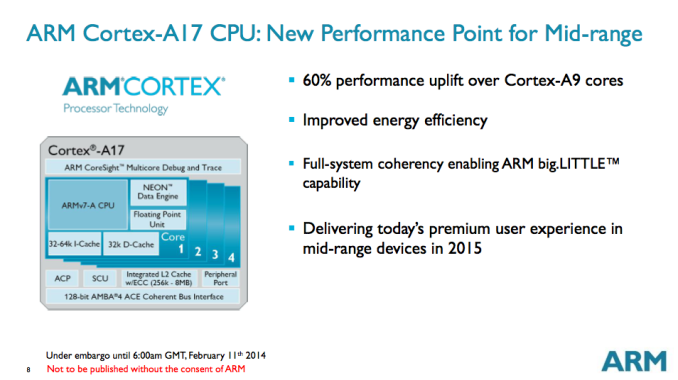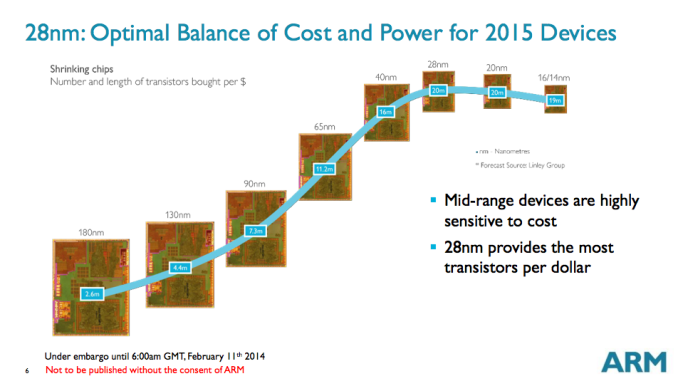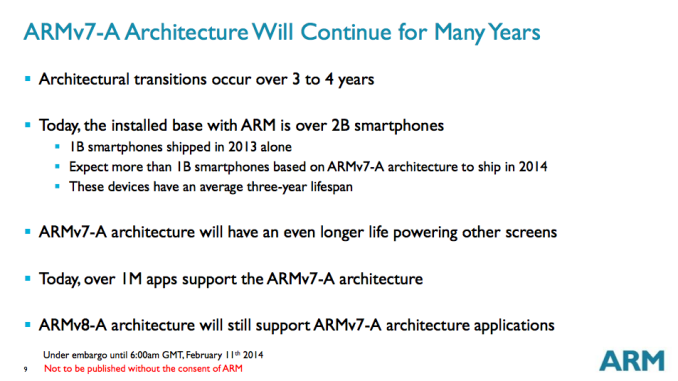ARM Cortex A17: An Evolved Cortex A12 for the Mainstream in 2015
by Anand Lal Shimpi on February 11, 2014 1:00 AM EST- Posted in
- SoCs
- Arm
- Smartphones
- Mobile
- Tablets
- Cortex A17

ARM has been doing a good job figuring out its PR strategy as of late. In the span of a couple of years we went from very little outward communication to semi-deep-dives on architecture and a regular cadence of IP disclosures. ARM continues its new trend today with the announcement of its 2015 mid-range CPU IP: the Cortex A17.
As its name implies, the Cortex A17 is a 32-bit ARMv7-A CPU design (64-bit ARMv8 cores belong to the Cortex A50 series - e.g. A53/A57). The best way to think about Cortex A17 is as an evolution of the recently announced Cortex A12, rather than anything to do with the Cortex A15. ARM's Cortex A17 takes the basic 2-wide out-of-order architecture of the Cortex A12 and improves it. Specific details are still light at this point, but I'm told that the front end and execution engine are similar to Cortex A12, with most of the performance/efficiency gains coming from improvements to the memory subsystem.
The result is a design that is roughly 60% faster than a Cortex A9r4 at a given frequency/process/memory interface (Cortex A12 is 40% faster than A9r4 under the same conditions). Using ARM's own DMIPS/MHz ratings I threw together a little table of relative/estimated performance ratings to help put all of this in perspective:
| ARM 2014/2015 CPU IP lineup | |||||||||
| CPU IP | Target | Estimated DMIPS/MHz | big.LITTLE | Shipping in Devices/Systems | |||||
| Cortex A57 | High-end mobile/servers | 5* | Yes (w/ A53) | 2015 | |||||
| Cortex A53 | Low-end mobile | 2.3 | Yes, LITTLE, w/ A57 | 2H 2014 | |||||
| Cortex A17 | Mid-range mobile | 4.0* | Yes, big, w/ A7 | Early 2015 | |||||
| Cortex A15 | High-end mobile | 4.0* | Yes, big, w/ A7 | Now | |||||
| Cortex A12 | Mid-range mobile | 3.5 | No | 2H 2014 | |||||
| Cortex A9 | High-end mobile | 2.5 | No | Now | |||||
| Cortex A7 | Low-end mobile | 1.9 | Yes, LITTLE, w/ A15/A17 | Now | |||||
*Estimate based on ARM's claims
On a given process node, the Cortex A17 can occupy around 20% more area than a Cortex A9 or a marginal increase over a Cortex A12 design. Running the same workload, ARM expects the Cortex A17 to be 20% more energy efficient than the Cortex A9 (race to sleep), but I'd expect higher peak power consumption from the A17. The Cortex A17 name was deliberately chosen as ARM expects to be able to deliver similar performance to the Cortex A15 (in mobile apps/benchmarks, likely not in absolute performance), but in a much smaller area and at a lower power. I can't help but wonder if this is what the Cortex A15 should have been from the very beginning, at least for mobile applications.
ARM expects many early Cortex A17 designs to be built on a 28nm process, with an eventual shift over to 20nm once the cost of that process drops. ARM supplied an interesting slide showcasing the number of transistors $1 will buy you as a function of process node:
If you're a fabless semiconductor, it looks like 28nm will be the sweet spot for manufacturing for a little while.
Keep in mind that the target market for the Cortex A17, like the Cortex A12, is somewhere in between a device like the Moto G and the latest flagship Galaxy S device from Samsung.
big.LITTLE Support
If you remember back to our analysis of the Cortex A12, the first version of the core didn't support ARM's big.LITTLE (lacking the requisite coherent interface) but a future version was promised with big.LITTLE support. The Cortex A17 is that future version. In a big.LITTLE configuration, the Cortex A17 will function as the "big" core(s) while the Cortex A7 will serve as the "LITTLE" core(s).
Rather than giving the Cortex A12 a new major revision number, ARM improved the design, added big.LITTLE support and called the finished product the Cortex A17. It's an interesting approach to dealing with the fact that ARM can rev/improve a single IP offering many times over the course of its life. In case it isn't already obvious, there won't be a big.LITTLE version of the Cortex A12.
ARM expects some overlap between Cortex A17 and Cortex A12. If a customer is looking to ship in 2014, Cortex A12 will be the only option for them in the mid-range from ARM. If a customer wants big.LITTLE or they are starting a design now, Cortex A17 is the obvious fit. I expect Cortex A17 will contribute to a relatively short lifespan for Cortex A12 in the grand scheme of things.
ARM sees some of the biggest opportunities in addressing the entry level and performance mainstream smartphone markets going forward. With the Cortex A17 aiming at the latter, ARM sees a potential market of around 450 million devices in 2015. The lack of 64-bit support makes ARM's mid-range lineup a little odd, especially considering the Cortex A53 and Cortex A57 will ensure both entry level and high-end smartphones will be 64-bit enabled. While I don't have an issue with a good mid-range device shipping without 64-bit support, I'm not sure how handset and tablet OEMs will feel. With Apple, Intel (and likely Qualcomm), embracing 64-bit-only strategies in mobile, I do wonder just how much success these A12/A17 architectures will have over the long run.
ARM tells me we should see the first devices using Cortex A17 CPU cores shipping in early 2015. Cortex A17 IP will be available to ARM customers for implementation by the end of this quarter.














41 Comments
View All Comments
Wilco1 - Tuesday, February 11, 2014 - link
From the details it seems A17 is similar in IPC and frequency as A15 and yet is more power efficient, so will beat S4plus by a good margin. It'll challenge the Snapdragon 800 as well.extide - Tuesday, February 11, 2014 - link
So, I will say it... Really, another ARMv7 core?! With Qualcomm bringing out the SD410, and whatnot, this seems like an odd choice. Obviously these cores (A12/A17) have been in development for a while (since way before Apple released the 64-bit A7) and so ARM was caught off-guard like everyone else, and instead of just ditching these cores, they finished them out. I would only hope they have a plan to migrate one of these designs into a ~A55 mid-range 64-bit ARMv8 chip.name99 - Tuesday, February 11, 2014 - link
ARM is interested in selling to more than just high end cell manufacturers. Why is this so hard to understand? They weren't competing on performance back in 2005, before Apple made them a company geeks actually follow, and they aren't competing on performance today.If you want a kickass mobile CPU (and are willing to pay for it) well Apple make their own, Qualcomm and nVidia would like your business, and Samsung may one day play that game. But if you want a functional CPU, low power, low price, and plan to ship a million, ARM are happy to work with you.
32 bits is over? Hmm.
Is 32 bit necessary for low-end network appliances (WiFi base stations, SoHo routers, VoIP phones)? How about for low-end smart TVs? How about for wearables?
You will NEVER understand how and what ARM do if you insist on imagining that they go to bed every night thinking about how they can make a chip as fast as a Haswell. They ARE NOT INTERESTED IN THAT BUSINESS. That, as much as anything else, explains, for example, why Apple felt it made sense to go down the expensive and risky path of making their own CPU., and why Qualcomm have a great little niche of their own in the ARM ecosystem.
Wolfpup - Tuesday, February 11, 2014 - link
Considering even the most expensive ARM SOCs are effectively free, I don't understand why every phone or tablet doesn't just use the best available. They could charge $50 more and be making a big profit!Oh well...
Once again I have to wonder about this as I did with A12...isn't it coming really late? Shouldn't everything be 64-bit by next year?
DanNeely - Tuesday, February 11, 2014 - link
the core market of lower end chips is the developing world phones where a $1 is a few hours of income not a few minutes; so your $50 is days or even weeks of disposable income and low cost embedded devices where profit margins are very narrow and a few dollars more on the BOM means your competition crushes you on price.sonicmerlin - Tuesday, February 11, 2014 - link
Except that phones with low end chips are also sold In developed countries, so your argument doesn't hold water. The difference between top of the line SoC and lowest tier is at most $10. The real reason they're not used is because the OEMs want to artificially stratify the market to increase consumer incentive buy their ultra high margin $600 devices.BMNify - Wednesday, February 12, 2014 - link
so what , you,assuming your not living in a developing world and are one of the many lowest income family's there YOU can get your water far cheaper than they are paying for their pre payed metered water (probably running another ARM soc there), so by your argument that means it's ok to charge them a higher % of their total income for products and services ,assuming they actually have an income to buy these things OC, a mobile/tablet with internet connection to help educate their whole family and neighbors in their village for instance....Novacius - Tuesday, February 11, 2014 - link
I'm wondering why ARM doesn't bring a Cortex A55 which could virtually be an A17 with ARMv8 and 64 bit support. You can buy 64 bit parts (A53&A57) this year, but why is the mainstream so far behind? Of course one can argue that ARMv8 makes the whole thing bigger and more expensive, but (1) the difference wouldn't be very huge in terms of die area (unlike the royalties, which are higher), (2) they already have 64 bit in the low end with A53 and (3) companies who want a 32 bit part could use the A12 instead of the A55, like they can do with A7/A53.I just don't get it. The mainstream market is very important for 64 bit in smart devices (OSes, Apps). In ARM's place I would push 64 bit as much as I can. They have to make sure their processors are the choice of the future, and ARMv8 is a crucial part of doing so.
DanNeely - Tuesday, February 11, 2014 - link
Because 64 bit isn't needed anywhere but at the top yet. A53 is only a 64bit part because making big.LITTLE work requires both cores to use the same ISA.Krysto - Tuesday, February 11, 2014 - link
Me, too. But it's too late for A55 now. A55 should've been A12, or A17 at most, so they arrive roughly at the same time. Now they'll have to wait for the successors of A53 and A57 to come out, let's call them A73 and A77. When they announce those two, they should also be announcing a mid-range ARMv8 A75.But since A53 were announced for 2014 basically, these next 3 chips will be announced for 2016, at the end of 2015. That's why I'm saying in my other comment that ARM has basically artificially prolonged the ARMv7 lifetime by another 2 years, and it really pisses me off.
Because if it meant that from 2016 all apps and Android versions supported would be 64-bit, it would be one thing. But since these A17 chips will be effectively sold into NEW devices even in early 2016, and probably longer than that, and that means developers will have to support these 32-bit devices for at least another 3 years, until those people get rid of them.
So we're looking at ARMv7 being supported into 2019, possibly 2020, when it could've been 2018 at most, and at that point all apps and Android versions would be 64-bit-ONLY, and drop 32-bit legacy support. All because of ARM's dumb move. Thanks ARM...